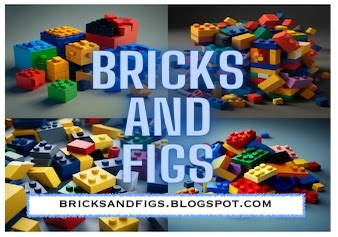Hi brick fans! I'm back with another MOC, this time I've rebuilt the JMBricklayer Coffee shop 21102. I reviewed the original set here on my other blog Its-Not-Lego.I placed the original completed Coffee Shop in my not Lego city just to see how it looks. Um, yeah let's see what we can do.
Ok, here's the newly revised Coffee Shop which I have basically rebuilt from the ground up. The first thing you will notice is the raised baseplate on a standard 16x32 stud footprint. This meant that I had to completely destroy the original folding baseplate that let you open the interior for display.
Next you will notice the large and colourful tree, which was originally located inside has been moved to the outside.
The front door has been replaced and the height of the building has been significantly lowered to reflect the minifig scale. Flanking the entrance door on either side are some potted plants that used to sit in the previous and now defunct plant stand.
The original masonry bricks have been salvaged and will be reused in a future building.
Moving to the rear of the shop, it has been completely revamped with glass instead of brick. You will notice that the slanted roof now has new window glass which was not in the original set.
Just another view of the back.
I've reconfigured the roof and it is now comprised of three sections. The white roof sits directly over the front of the coffee shop. The new widened roof still features the original skylight, but now it has been centered into the roof and the previously exposed studs are now covered.
The black sloping roof was redesigned to come off, yet still hold the dark nougat roof panel securely in place. The angle of the slope has not changed too much.
The dark nougat roof panel has been widened to 16 studs in width and sports glass panes in all the windows as previously mentioned.
Looking down into the seating area, with roof removed.
With all roof panels removed, here is the full view of the coffee shop interior. I really had to scrounge through my spare parts to find all the dark nougat tiles that I used for the flooring. I had to get a bit creative in laying out the tiles based on what was available, (mostly 2x2 and 1x2 tiles), but also I also had to judiciously use the tiles with the single stud to mount my tables and chairs.
Betty the barista is back behind the counter. I've added a lot more minifigures to the coffee shop to fill up the extra space.
I replaced the legacy long table with three smaller tables with accompanying chairs in the seating area.
Oh, before I forget, I want to mention the Coffe Home shop sign. As you know the spelling is incorrect and it would be naturally expected that I remove or replace the sign with the correct wording.
But then it occurred to me that I would be placing the coffee shop with all of my other Japanese shops, and I thought what if the shopkeeper didn't have a proper command of the english language and inadvertently spelt the sign wrong.
I've actually seen some gibberish English signage on some storefronts in my past trips to Japan and China. So, instead of replacing the signage, I thought I would keep it exactly as it was, just to acknowledge that maybe there was some kind of language barrier. I think that in the end, it kind of gives the shop some extra character that is unique and differentiates it from my other buildings.
Don't forget you can get the JMBricklayer Coffee shop 21102 (in it's original form, of course) at the JMBricklayer shop or their Amazon store. And don't forget to use my code ITSNOTLEGO15 to save an extra 15% off their online store purchases (non sale items only).
Thanks and have a great day! Bye!























































